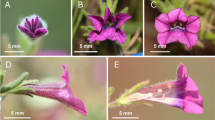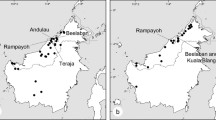Abstract.
Various aspects of the reproductive biology of Atamisquea emarginata Miers ex Hook. et Arn. were studied in a population from Tucumán, northern Argentina. Flowering took place in late (austral) spring to early summer. The creamy white, entomophilous flowers were protandrous and lasted 3.5–4.5 days. A pleasant odor along with nectar and pollen attracted 36 mostly diurnal insect species of which 41.7% were Hymenoptera, 38.9% Lepidoptera and 19.4% Diptera. However, 75% from all recorded species were infrequent, and domestic bees made ca. 94% of all visits. One halictid bee, one sphecid wasp, one myzinid wasp, four small- to medium-sized butterflies and a hawkmoth completed the set of relatively frequent insect visitors. Pollen and stigma were presented in the same place within the flower, but interference was prevented by a movement-assisted, complete dichogamy mechanism in which the bending ability of the gynophore played a fundamental role. This form of dichogamy was previously unknown in the Capparaceae. In comparison with the known species of the closely allied genus Capparis L., A. emarginata has diurnal, smaller, longer-lasting flowers, that offer much smaller nectar amounts, and that attract a rather generalized array of non-hovering visitors, while Capparis behaves as a more crepuscular-biased sphingophile or ornithophile or chiropterophile. Low levels of seed set under bagging indicates dependence on insect visits and are partly congruent with an earlier report of self-incompatibility in A. emarginata. Pollen tubes arrived to ovules in 90.6% of the inspected flowers. Fruit set of open-pollinated flowers was 43.6%–53.7%. Ninety-five percent of all ovules were regularly aborted in each fruiting ovary; thus, each fruit contained 1.2 developed seeds. Full-sized individuals were expected to produce ca. 10,700 potential offspring per year.
Similar content being viewed by others
Author information
Authors and Affiliations
Additional information
Received August 19, 2002; accepted October 8, 2002 Published online: February 7, 2003
Rights and permissions
About this article
Cite this article
Medan, D., Ponessa, G. Movement-assisted dichogamy in Atamisquea emarginata (Capparaceae). Plant Syst. Evol. 236, 195–205 (2003). https://doi.org/10.1007/s00606-002-0241-x
Issue Date:
DOI: https://doi.org/10.1007/s00606-002-0241-x




